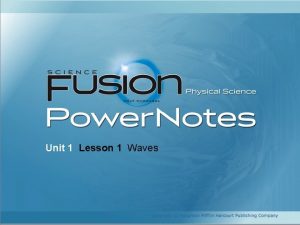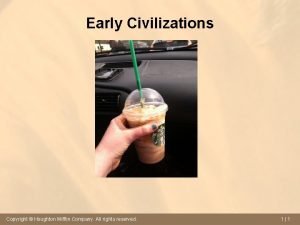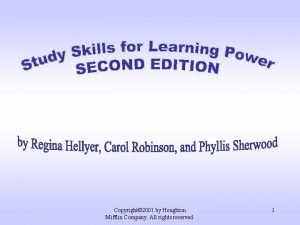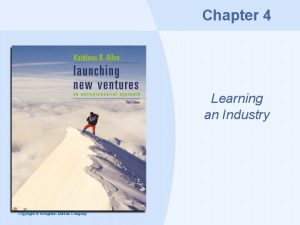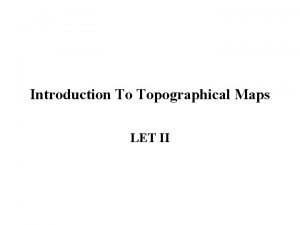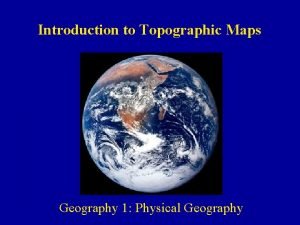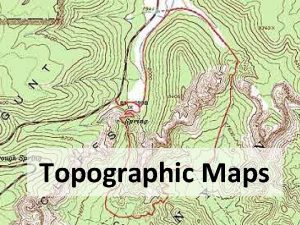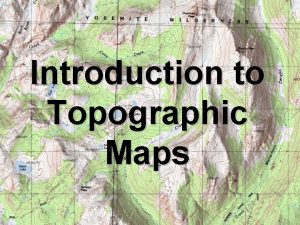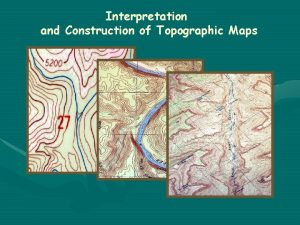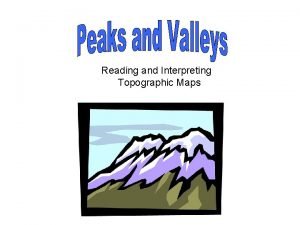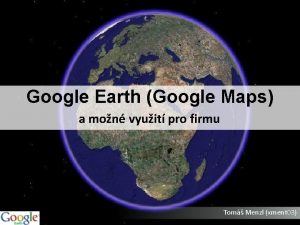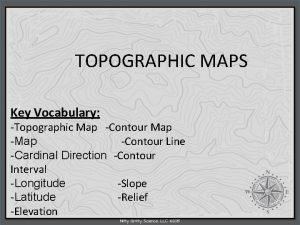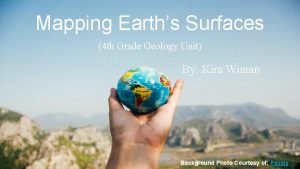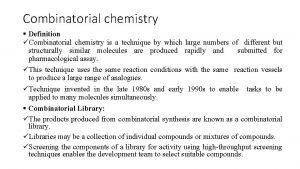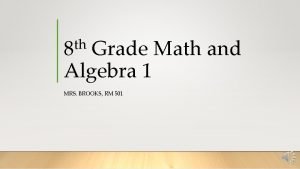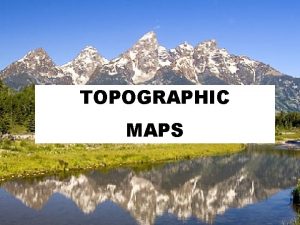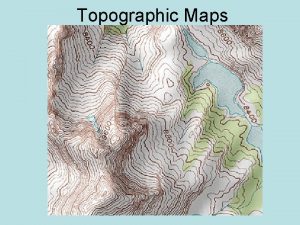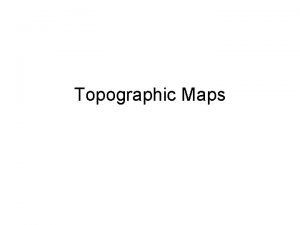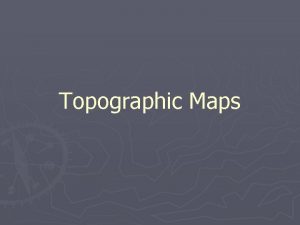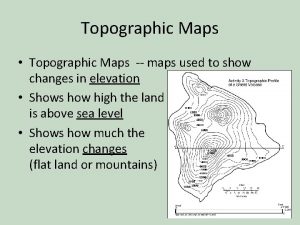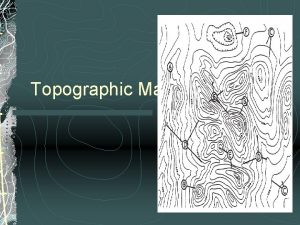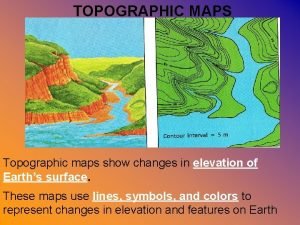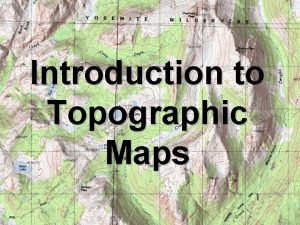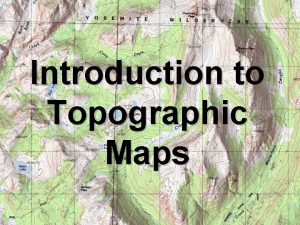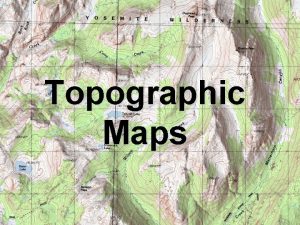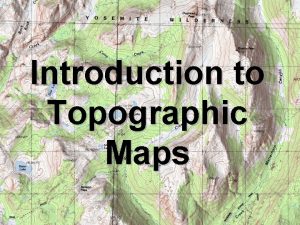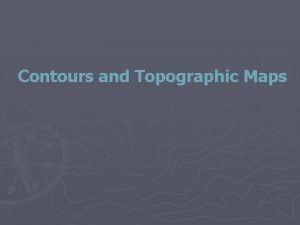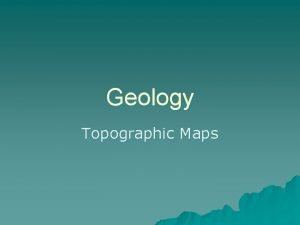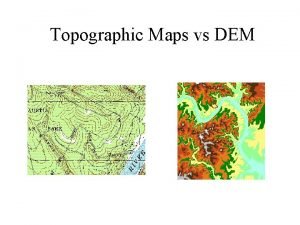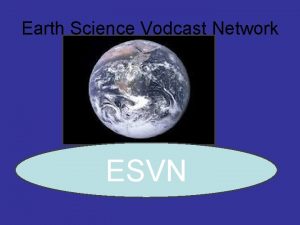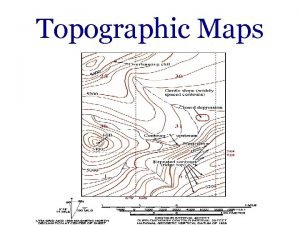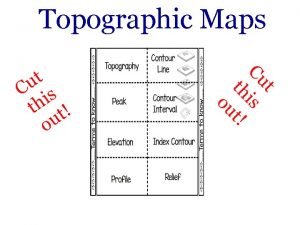Unit 7 Lesson 4 Topographic Maps Copyright Houghton






















- Slides: 22

Unit 7 Lesson 4 Topographic Maps Copyright © Houghton Mifflin Harcourt Publishing Company

Unit 7 Lesson 4 Topographic Maps Where on Earth? What are some ways to represent Earth’s surface? • Maps are models that represent Earth’s surface and can show many different types of information. • Aerial and satellite images can look like regular photographs or be enhanced to show information that would not be visible otherwise. • Geologic maps show rock types and ages, as well as fault lines and elevations. Copyright © Houghton Mifflin Harcourt Publishing Company

Unit 7 Lesson 4 Topographic Maps What are some ways to represent Earth’s surface? • A topographic map shows the shape of Earth’s surface with lines that represent different elevations. • Most lines on a topographic map are called contour lines, and they connect points of equal elevation. • Contour lines form closed loops, almost never cross, and are spaced depending on the land’s steepness. Copyright © Houghton Mifflin Harcourt Publishing Company


Unit 7 Lesson 4 Topographic Maps How do topographic maps show relief? • Relief is the difference between the highest and lowest elevations in a particular area. • A contour interval is the difference in elevation between two contour lines. • An index contour is a thicker contour line that often has an elevation label. Copyright © Houghton Mifflin Harcourt Publishing Company

Unit 7 Lesson 4 Topographic Maps How do topographic maps show locations of features? • Points, lines, and area symbols are used to represent features on topographic maps. • Points mark locations, such as mountain peaks and buildings. • Lines may represent features such as rivers, trails, roads, and boundaries. • Colored or textured areas are typically used to represent different types of land cover. Copyright © Houghton Mifflin Harcourt Publishing Company

Unit 7 Lesson 4 Topographic Maps How can you identify land features on topographic maps? • Certain patterns of contour lines can help you identify different types of land features. • Contour lines with a V shape may represent valleys or ridges. • Closed circles may represent hills or depressions. • Contour lines stacked very close together represent a steep land feature. Copyright © Houghton Mifflin Harcourt Publishing Company

Unit 7 Lesson 4 Topographic Maps How can you measure Earth’s surface using a topographic map? • A map scale shows the relationship between the sizes and distances shown on the map and the actual measurements on Earth’s surface. • Slope measures steepness from one point to another. • For slope in a topographic map, the rise is the change in elevation, and the run is the horizontal distance between two points. Copyright © Houghton Mifflin Harcourt Publishing Company

Unit 7 Lesson 3 Weathering, Erosion, and Deposition Copyright © Houghton Mifflin Harcourt Publishing Company

Unit 7 Lesson 3 Weathering, Erosion, and Deposition Crushers! What is weathering? • Weathering is this process by which rock breaks down into smaller pieces or changes composition. • Weathered rock pieces, known as sediment, are an important component of soil. • Differential weathering describes how different rocks in the same environment can weather at different rates. Copyright © Houghton Mifflin Harcourt Publishing Company

Unit 7 Lesson 3 Weathering, Erosion, and Deposition What is weathering? • Physical weathering is the breakdown of rock into smaller pieces. Physical weathering does not change the chemical makeup of a rock. • Chemical weathering changes the chemical makeup of a rock. • Physical weathering and chemical weathering often work together in nature. Copyright © Houghton Mifflin Harcourt Publishing Company

Unit 7 Lesson 3 Weathering, Erosion, and Deposition What causes physical weathering? • Abrasion is a process where agents, such as wind, water, and ice, carry particles that scrape against rock. • Plant roots can grow into the cracks of a rock and break the rock into pieces. Water accomplishes a similar feat by seeping into cracks, freezing, and expanding. • Digging animals can expose buried rocks to agents of physical weathering. Copyright © Houghton Mifflin Harcourt Publishing Company

Unit 7 Lesson 3 Weathering, Erosion, and Deposition What causes chemical weathering? • Two main agents that cause chemical weathering are oxygen and acids. • Oxidation occurs when certain chemicals in a rock react with oxygen to form new chemical compounds. • Acid precipitation can speed up chemical weathering. • Microscopic organisms, lichens, and mosses can also cause chemical weathering. Copyright © Houghton Mifflin Harcourt Publishing Company

Unit 7 Lesson 3 Weathering, Erosion, and Deposition Earth Movers What are erosion and deposition? • Erosion transports rock, sediment, and soil from one place to another. • Deposition lays down rock, sediment, and soil. • Erosion and deposition work together, constantly reshaping Earth’s surface. Copyright © Houghton Mifflin Harcourt Publishing Company

Unit 7 Lesson 3 Weathering, Erosion, and Deposition What causes erosion and deposition? • Wind, water, ice, and gravity are agents of both erosion and deposition. • Flowing water moves millions of tons of sediment every day. • A glacier is a large mass of ice that exists yearround and flows slowly over land. • Alpine glaciers can erode land to form jagged ridges and peaks. Continental glaciers can leave depressions in the land in which lakes form. Copyright © Houghton Mifflin Harcourt Publishing Company

Unit 7 Lesson 3 Weathering, Erosion, and Deposition What causes erosion and deposition? • Wind can move soil and sediment. Wind erosion and deposition creates sand dunes. • Gravity causes rocks and soil to move down a slope, a process known as mass movement. • Gravity also determines the movement of other agents of erosion, such as water and ice. Copyright © Houghton Mifflin Harcourt Publishing Company

Unit 7 Lesson 3 Weathering, Erosion, and Deposition Shore Shapers How can weathering and erosion shape coastal features? • Ocean waves and currents play a large role in shaping Earth’s shoreline. • Weathering and erosion along a shoreline can form sea cliffs, wave-cut platforms, sea caves, sea arches, and sea stacks. • Some parts of a shoreline may erode faster than others, leaving behind headlands. Copyright © Houghton Mifflin Harcourt Publishing Company

Unit 7 Lesson 3 Weathering, Erosion, and Deposition How can deposition shape coastal features? • Waves and currents deposit material to form features, and beaches are the main features of coastal deposition. • Longshore currents can deposit materials offshore to create features such as sand spits, tombolos, and barrier islands. Copyright © Houghton Mifflin Harcourt Publishing Company

Unit 7 Lesson 3 Weathering, Erosion, and Deposition Drip, Drop How can flowing water shape land? • Weathering and erosion by flowing water form various land features, such as valleys, cliffs, and canyons. • Acids in groundwater can slowly dissolve rock to form caves. Copyright © Houghton Mifflin Harcourt Publishing Company

Unit 7 Lesson 3 Weathering, Erosion, and Deposition How can flowing water shape land? • Deposition by flowing water forms features such as alluvial fans, deltas, and floodplains. • Cycles of flooding cause layers to build up along rivers, forming a flat floodplain. • Groundwater can deposit dissolved minerals in new locations to form stalactites and stalagmites. Copyright © Houghton Mifflin Harcourt Publishing Company

Unit 7 Lesson 3 Weathering, Erosion, and Deposition Ice Sculptures How can glaciers weather and erode Earth’s surface? • As glaciers move, they pick up material and scrape out the land beneath them. • Several land features characteristic of glacial weathering and erosion are cirques, glacial horns, and arêtes. Copyright © Houghton Mifflin Harcourt Publishing Company

Unit 7 Lesson 3 Weathering, Erosion, and Deposition What can melting glaciers deposit? • Glaciers also shape Earth’s surface by leaving behind lakes and deposits of rock and sediment. • Glacial deposition can create land features, such as glacial till, moraines, drumlins, erratics, and kettle lakes. Copyright © Houghton Mifflin Harcourt Publishing Company
 Copyright houghton mifflin company
Copyright houghton mifflin company Copyright houghton mifflin company
Copyright houghton mifflin company Customer mix manager
Customer mix manager Copyright houghton mifflin company
Copyright houghton mifflin company Copyright houghton mifflin company
Copyright houghton mifflin company Topographic map introduction
Topographic map introduction Large scale vs small scale map
Large scale vs small scale map Interpreting topographic maps worksheet
Interpreting topographic maps worksheet Whats a contour interval
Whats a contour interval Construction and interpretation of relief profile
Construction and interpretation of relief profile Vertical interval of a map
Vertical interval of a map Topographic maps show
Topographic maps show Topographic maps vocabulary
Topographic maps vocabulary Topographic map
Topographic map Independent practice: topographic maps
Independent practice: topographic maps Reittihaku google maps
Reittihaku google maps St john houghton
St john houghton Combinatorial chemistry definition
Combinatorial chemistry definition Houghton miffin
Houghton miffin Copyright images
Copyright images Sarah houghton librarian
Sarah houghton librarian Algebra 1
Algebra 1 Journeys literacy program
Journeys literacy program
